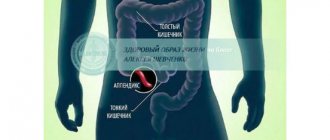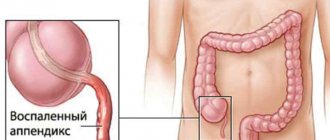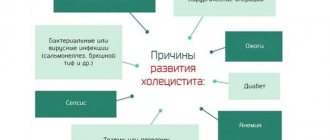Symptoms
What to look for if you suspect an attack of acute appendicitis?
The first symptom of appendicitis is acute pain in the right side. Many patients experience wandering pain that moves from the center of the abdomen to the lower right side. The nature of the pain is intense, cutting. The sensation intensifies if the patient walks, coughs, or turns over in bed.
In some cases, pain appears immediately in the lower right abdomen. This is characteristic of the typical position of the appendix, which can be seen on ultrasound.
In an atypical position, patients complain of pain:
- near the liver;
- in the groin;
- left.
Other symptoms of appendicitis are a temperature of 38° and loss of appetite. With complications, the patient shudders, pain dulls, and the pulse quickens.
Ultrasound examination is widely used in the diagnosis of diseases of the abdominal cavity. This is a painless and informative method that allows you to detect pathology, carry out differential diagnosis for diseases with similar symptoms, and clarify the diagnosis.
One of the most common pathologies in children and adults is inflammation of the appendix, or appendicitis. Let's consider whether appendicitis is visible on an abdominal ultrasound, and whether it is advisable to use this diagnostic technique.
To diagnose appendicitis, clinical, laboratory and instrumental methods are used. An experienced doctor can make a diagnosis based on complaints and examination of the patient in 50% of cases. In other cases, the manifestations of the disease may be hidden, or the patient’s complaints resemble other pathologies.
In such cases, X-ray diagnostics were previously used, which helped differentiate atypical forms of appendicitis. With the development of ultrasound, it began to be used when the clinical picture was in doubt and it was necessary to exclude diseases with similar symptoms. These include:
- acute or chronic cholecystitis;
- rupture of an ovarian cyst;
- ectopic pregnancy;
- acute pilonephritis;
- cystitis;
- urolithiasis disease;
- Crohn's disease;
- omental infarction;
- mesenteric lymphadenitis;
- carcinoid, etc.
Many of these pathologies give a clear picture on ultrasound, and this makes it possible to exclude inflammation of the appendix. But whether it is possible to determine whether there is appendicitis using an abdominal ultrasound depends on several factors, including the following:
- location of the cecum;
- presence of gases in the intestines;
- thickness of the subcutaneous fat layer.
Also, the patient’s individual sensitivity to pain plays a role during the examination, since it is carried out without preparation, the cecum normally contains a certain amount of gases, and the diagnostician uses dosed compression and pressure with a sensor to improve visualization.
This technique allows you to displace gases from the cecum, because they do not allow ultrasound to pass through, thereby creating an acoustic window for searching and studying the appendix.
The disease is registered in 10% of children over 5 years of age and people under 40 years of age, although the possibility of development in the elderly cannot be ruled out.
The vermiform appendix of the cecum is located in the region of the right iliac fossa and the inflammatory process in it is called appendicitis.
The disease begins acutely, with diffuse abdominal pain, then it gradually takes on a focal character and is localized in the lower right part of the abdomen.
The main complaints of patients are the following:
- pain does not always have a clear localization, can radiate to the navel, spine, subsidence and then re-development of severe pain often indicates perforation and the development of peritonitis;
- temperature usually does not exceed 38 degrees Celsius;
- nausea and vomiting, as well as loss of appetite, can mask the pathology as infectious toxic diseases;
- diarrhea, more common in children, together with fever is an important prognostic sign in children who cannot accurately describe their complaints.
Patients also have dry mouth, a coated tongue, and specific symptoms of appendicitis.
It is not always possible to see appendicitis on an abdominal ultrasound, especially if it has a retrocecal location. The search starts from the ileocecal angle, where it originates. Despite the fact that its dimensions can vary greatly, the diameter of the organ should not exceed 6 mm, and the wall thickness should not exceed 3 mm. It is the increase in diameter and wall thickness that is the first sign of inflammation.
Effusion can also be found in the abdominal cavity, for example, in the pouch of Douglas in women. The tissues surrounding the process become hyperechoic and denser. This is due to their infiltration by leukocytes and macrophages.
In the future, with the development of the disease, perforation of the wall of the appendix and the release of contents into the abdominal cavity are possible, with the formation of purulent cavities. Ultrasound shows discontinuity of the wall and a hypoechoic formation adjacent to the process.
What symptoms can be used to recognize appendicitis are presented in this video.
Abdominal ultrasound for diagnosing appendicitis has the following advantages:
- safety;
- ease of implementation;
- cheapness;
- non-invasive;
- high information content.
Treatment of appendicitis
The only effective treatment for acute appendicitis is appendectomy - removal of the appendix. The operation can be performed in two ways; the choice of surgical intervention remains with the surgeon.
For catarrhal and superficial appendicitis, laparoscopic surgery is usually performed; the inflamed appendix is removed through small holes in the abdominal cavity. The operation lasts no more than forty minutes. Gangrenous and perforated appendicitis requires extensive surgical intervention. Abdominal surgery can last up to three hours, depending on the extent of inflammation.
After surgery, the child spends 4-5 days in the hospital. Doctors monitor the condition of the body: measure body temperature, evaluate the results of repeated tests and ultrasound.
Carrying out the procedure
If pain is mild, or if the pain area is located in an atypical location, the analysis is carried out in the following way:
- Study of the apex of the cecum.
- Detection of iliac vessels.
- Study of the iliac muscle.
- Study of the place behind the cecum.
- Analysis of the condition of the peritoneal and pelvic organs.
- Especially for women, the right ovary is examined.
The final diagnosis is made by the doctor. There is not always enough data to make an adequate diagnosis. Some cases require additional tests, diagnosis using MRI, laparoscopy or CT. Conclusions are drawn based on the results of all types of research.
Ultrasound is often prescribed after removal of the appendix, especially if complications occur or a sharp deterioration in the patient’s condition, allowing one to see the internal source of the complication.
Carrying out in women
The female body is structured somewhat differently. Therefore, the appearance of pain characteristic of appendicitis may indicate gynecological problems in the form of inflammation of the appendages or ectopic pregnancy. Therefore, a doctor cannot make a correct diagnosis only on the basis of palpation of the peritoneum and the results of blood and urine tests. This is exactly the option where ultrasound is indispensable.
During the procedure, a clear source of pain is visible. An examination of the peritoneal and pelvic organs reflects the condition of the appendages and appendix, allowing one to diagnose the exact cause of the ailment. The procedure when examining female patients is performed more often due to the structural features of the female body.
In addition, during menstruation, a woman’s uterus swells, increases in volume and displaces other organs in the abdominal cavity. During pregnancy, the uterus enlarges many times; in addition to displacement, it compresses and disrupts blood circulation in the gastrointestinal tract, which leads to inflammatory processes. In this case, ultrasound remains a relevant research method that can show an accurate picture.
Children are not always able to describe the symptoms of an attack and cannot indicate where the pain is located. Conducting an ultrasound examination in children is a safe and quick way to determine the cause of pain and an accurate diagnosis. The attack itself develops much faster in a child than in adults.
This is due to the physiology of the child’s structure and the course of metabolic processes. An attack can be triggered by ARVI or tonsillitis, poor diet, dysbiosis, or gastritis. An ultrasound will show the source of inflammation and the cause of its development.
In some cases, removal surgery is contraindicated and antibiotic therapy is prescribed. Appendicitis gradually becomes chronic. The described point requires a mandatory ultrasound examination two or three times a year to monitor the condition of the appendix. This is necessary because the disease in a chronic condition can occur covertly and lead to aggravating consequences for human health.
Ultrasound diagnostics is an informative, safe, accessible method for identifying pathology in acute appendicitis. The procedure will help the doctor differentiate the ailment from other diseases, see inflammatory processes, exclude or determine the presence of problems in neighboring abdominal organs. Diagnostics can make it possible to establish the correct diagnosis, and if there is insufficient data, it is supplemented by laboratory tests, MRI or CT.
It is important to take good care of your health, monitor your physical fitness and well-being, and seek help in a timely manner if you feel unwell. A strong immune system will allow you to maintain health, prevent the development of pathological conditions and complications, and ensure a speedy recovery from illnesses. Well, if the body malfunctions and medical attention is required, modern research methods in the form of diagnostics using ultrasound will help make an accurate diagnosis and identify the true cause of the disease.
When the patient takes a comfortable position on the couch, the sonologist will set up the equipment, take the sensor-generator in his hand, treat its main part with a colorless conductive gel and carefully begin to move the device over the surface of the abdomen. During an ultrasound examination, dosed compression will be performed - that is, gentle pressure on certain areas of the abdominal cavity, designed to improve visualization of the intestinal tract.
Sometimes a woman needs transvaginal diagnosis, for example, if she is overweight. In this case, an ultrasound is performed using a special narrowed sensor, which is inserted into the vagina. If during the procedure the lady experiences severe discomfort or pain, it is necessary to immediately notify the specialist about the unpleasant sensations. If obvious, most acute signs of appendicitis are detected, medical personnel may immediately send the patient to the operating room.
Classic anatomical location of the appendix
Ultrasound of the appendix in pediatrics
Children at a young age are not able to accurately characterize pain sensations and their localization. They may cry and curl up.
Therefore, it is quite difficult to identify pathology. Appendicitis often develops in schoolchildren.
Due to its physiological structure, inflammatory processes in the appendix are associated with inflammation of several organs, which leads to peritonitis.
The provoking factor is a viral or bacterial pathological process, genetic predisposition, the presence of a foreign body in the appendix, feces.
The course of the disease itself in childhood is more complex than in adults. Appendicitis in a child occurs even due to acute respiratory viral infections, tonsillitis, measles, some pathologies of the digestive tract, etc., when therapy was started untimely.
Using ultrasound, it is possible to find out about the condition of the appendix, detect the root cause of negative changes and find out the condition of nearby organs for further treatment.
How is ultrasound performed?
The patient lies down on a horizontal surface and indicates the place where it hurts. The doctor carefully presses the sensor onto the peritoneum, reducing the distance between the device and the appendix to 0.5 cm. This way you can see appendicitis on an ultrasound and examine the appendix in detail.
The structure and position of the organ are visible on the monitor. In controversial cases, the diagnosis is repeated. If symptoms are mild or there is a suspicion of an atypical position of the appendix, the doctor examines the entire peritoneum and additionally the pelvic organs.
Doctor's office with ultrasound equipment
Healthy shoot
An ultrasound of the abdominal cavity shows appendicitis, which differs from inflamed appendicitis in the following signs:
- The structure resembles a multilayer tube.
- The diameter of the process is about 6 mm, the walls are thin 2–3 mm in diameter.
- Doesn't spasm.
An ultrasound shows appendicitis, which is inflamed. The disease is determined by the following signs:
- The structure of the process is heterogeneous, tuberous. In some places the walls are thickened.
- The organ is surrounded by loose, inflamed fluid.
- A wave-like contraction of the walls is observed.
- The appendix is enlarged.
Obesity and flatulence make diagnosis difficult. In addition, the risk group includes:
- children;
- aged people;
- pregnant women;
- people with reduced immunity.
Indications
Since an extremely advanced disease will soon lead to peritonitis, in no case should you ignore signs that may indicate appendicitis. Indicative physiological symptoms include:
- increased body temperature (up to 38.5 °C);
- prolonged pain in the abdominal area (often on the right);
- diarrhea;
- vomit;
- frequent urge to go to the toilet;
- abdominal wall tension;
- nausea;
- dry tongue.
The manifestation of a combination of the above ailments is a reason for an emergency visit/call of specialists.
Is appendicitis visible on ultrasound: how does diagnosis differ in adults, children and pregnancy
Diagnosis of appendicitis in children is complicated by the fact that the little patient is scared. The child assumes the fetal position due to severe pain and cannot accurately describe the symptoms. The pain is so severe because children have an attack of appendicitis and the symptoms are more pronounced than in adults. If you do not help the little patient, the appendix will develop from the catarrhal stage to the gangrenous stage within 24 hours.
A cold may be the cause of appendicitis in a child.
Often appendicitis becomes inflamed in children of primary school age. But most often in adolescence from 14 to 18 years.
The reason for this is:
- Entry of a foreign body into the appendix (stool or parasite).
- Past infection.
- Bad heredity.
The inflammatory process occurring in the appendix of the cecum is called appendicitis.
The disease often begins without any symptoms or has symptoms that are similar to other abdominal diseases.
This makes it difficult to diagnose the condition and can lead to complications (peritonitis, sepsis). Ultrasound for appendicitis helps determine the current condition of the patient, as well as the source of inflammation.
Using ultrasound, you can accurately determine the initial stage of the disease. This is due to the fact that most patients consult a doctor when the pain becomes unbearable, and ultrasound of the appendix is one of the only methods that can save a person’s life in an emergency.
Symptoms of classic appendicitis:
- aching, stabbing pain. During the first hours it is localized in the navel area, then it is felt in the lower right part of the abdomen;
- upset stool, nausea, vomiting;
- temperature rise to 40 degrees.
Diagnosis using ultrasound is carried out when:
- localization of the appendix, located atypically;
- non-standard nature of pain;
- signs of complications of appendicitis that require urgent surgical intervention;
- exclusion or confirmation of pathology in low-grade inflammation;
- a shift in the formula with an increase in leukocytes;
- laparoscopy and removal of appendicitis (appendectomy) to monitor the patient's condition.
Often the procedure allows you to detect a problem in emergency cases, so no special preparations are required.
During a routine ultrasound of appendicitis, you should adhere to the following rules:
- 2 days in advance, eliminate foods that cause gas formation;
- do not overeat;
- have a light snack two hours before the test.
To conduct an ultrasound for appendicitis in an adult, an abdominal sensor is used, which is moved along the abdominal wall in the lower right part of the abdomen.
Sometimes women have an atypical position of the appendix, and appendicitis is determined using a vaginal sensor.
During the examination, the specialist applies light pressure to the area being examined, which removes gases and makes it easier to make a correct diagnosis.
According to statistics, representatives of the fairer sex more often go to the doctor with appendicitis than men. This is due to the anatomical features of the pelvic organs. The genitourinary system is closely adjacent to the gastrointestinal tract; with the development and progression of pathology, inflammation is transmitted to the intestines.
Signs of the disease are similar to ectopic pregnancy or ovarian diseases. Ultrasound examination allows to exclude gynecological problems and prevent the development of complications.
In the later stages of pregnancy, the appendix moves upward, is often compressed by the growing uterus, and blood circulation to the organs deteriorates. With appendicitis, the nature of the pain has atypical symptoms and can be associated with other diseases, which is dangerous for the child and the expectant mother.
In childhood, an ultrasound is necessary because the child cannot accurately describe where it hurts. Appendicitis in children is a life-threatening condition, since there are many blood vessels in the abdominal cavity, the inflammation can quickly develop into peritonitis.
Signs of the disease in a child are accompanied by crying, pulling the legs towards the stomach, and whims. The inflammation is acute, with impaired venous circulation and swelling of the intestinal mucosa.
The condition can only be cured through surgery.
The condition is assessed after examining the intestines on the screen. You can see on an ultrasound not only signs of appendicitis, but also other diseases of the abdominal cavity.
Norm concepts:
- the structure of the appendix has a slightly curved shape, several layers of tissue lining the appendix are clearly visible;
- round section;
- blind (rounded) end;
- wall diameter up to 5–6 mm, thickness – 3–4 mm.
Signs of appendicitis on ultrasound:
- swelling, the presence of fluid in the organ itself - an increase in size and diameter;
- increased echogenicity (white staining of tissue, which indicates an inflammatory process) in the omentum and fatty tissue;
- discontinuous, layered structure of the appendix;
- uneven thickening of the walls;
- in advanced cases, when there are symptoms of an acute abdomen, an abdominal abscess is visible.
There are several reasons why your stomach may hurt badly. One of them is inflammation of the cecal appendage. If such a diagnosis is suspected, the doctor prescribes an ultrasound of appendicitis. This is a popular diagnostic method that provides the doctor and patient with comprehensive information about the condition of tissues and internal organs.
Timely diagnosis can sometimes be a matter of life or death.
Important! It is ultrasound that allows you to quickly detect a tumor at the very beginning of its development or find the epicenter of inflammation.
When is it prescribed?
Some symptoms are considered typical for inflammation of the appendix. Half of the patients who go to the doctor with acute abdominal pain suspect appendicitis and find symptoms characteristic of this disease.
The rest talk about other symptoms, which may well be manifestations of other diseases.
It happens, and vice versa - with manifestations of seemingly typical appendicitis, but the final diagnosis reflects the problem of another organ.
Important! Symptoms of an inflamed appendix depend on its location.
The disease occurs atypically in the following categories of patients:
- aged people;
- patients with reduced immunity;
- pregnant and lactating women;
- children.
It is recommended to do an ultrasound of the appendix in the following cases:
- With atypical localization of the appendix. This leads to a change in symptoms and without an ultrasound examination it becomes problematic to make a correct diagnosis.
- If the disease proceeds non-standardly.
- If appendicitis is complicated and requires immediate surgical intervention. In this case, ultrasound is used as the most accurate and fastest way to find out all the necessary information.
- If the doctor suspects inflammation of the appendix, but the symptoms are mild, ultrasound can help quickly make a diagnosis.
- If a blood test shows a shift in the formula with an increase in the number of leukocytes.
- If it is necessary to exclude that the appendix of the cecum is inflamed against the background of implicit, vague symptoms of the disease.
Initially, the specialist searches for the appendix, after which it is checked for the presence of an inflammatory process. During such an audit, the goal is to determine:
- size of the appendix and its location;
- availability of content, its nature and volume;
- thickness of the walls of the process;
- location of the appendix and the condition of adjacent tissues;
- condition of nearby organs.
Ultrasound examination of the appendix in adults and children includes several stages:
- examination of the upper rectum;
- search for iliac vessels;
- examination of the iliacus muscle, as well as the space behind the ileum;
- examination of the area located behind the cecum;
- examination of the small pelvis, rectouterine cavity and right ovary.
The physiology of the female body does not always make it possible to understand the real cause of abdominal pain.
Important! Symptoms of appendicitis can be mistaken for signs of an ectopic pregnancy or inflammation in the pelvic organs.
Appendicitis occurs more often in the fair sex, and this is due to physiological differences between male and female bodies. The reason is that the female genital organs are almost adjacent to the organs of the gastrointestinal tract.
Reference! During regular female bleeding, blood circulation in the pelvic organs increases and the uterus enlarges. It can put pressure on nearby organs, including the appendix.
Typically, an ultrasound of the appendix is performed through the abdominal wall, but it happens that women are examined using a transvaginal probe. In this way, the examination better shows the appendix.
In pregnant women
During pregnancy, the appendix undergoes mandatory examination. There is an opinion that gestation can be an impetus for the development of appendicitis.
Reference! The growing uterus displaces nearby organs, and the appendix becomes pressed against the intestines.
If the appendix is crushed, its blood circulation is impaired and the risk of inflammation increases. Statistics say that most often an inflamed appendix is removed during pregnancy; the risk of inflammation is especially high in the later stages of gestation.
Preparation
For appendicitis, no special preparation is required from the patient. In addition, ultrasound is usually performed on an emergency basis. When a patient admitted to the hospital experiences an acute phase of appendicitis, the diagnosis can only be quickly clarified using ultrasound.
During a routine examination, the patient must adhere to several simple rules:
- do not overeat;
- do not eat foods that cause flatulence;
- Do not come to the procedure hungry.
The condition of the appendix is assessed based on the results of an ultrasound examination.
A normal appendix should have the following features:
- curved shape and tubular structure consisting of several layers of fabric;
- round section;
- blind ending;
- absence of contractions of the walls and contents;
- wall diameter – up to 6 mm, thickness – up to 3 mm.
An inflamed appendix manifests itself on ultrasound as follows:
- tubular structure ending blindly;
- cross section similar to the target;
- impossibility of compression;
- increased wall thickness and diameter;
- In the lumen of the appendix, it is possible to detect a fecal stone with a diameter of no more than 1 cm.
An ultrasound may reveal signs of a violation of the integrity of the appendix:
- abrupt and layered structure of uneven walls of the process;
- increasing the density and echogenicity of the omentum due to its inflammation;
- effusion in the peritoneum and in the area where the appendix is located;
- abscesses of intestinal loops.
What can an ultrasound of the appendix show?
Is it possible to detect appendicitis using ultrasound? The answer to this question is still open, since sometimes the pathology is not visualized, and clinical manifestations clearly indicate an inflammatory process.
Ultrasound of the appendix during inflammation determines the anatomy and location of the appendix, changes in tissue and intestinal walls, but sometimes the inflammatory process remains invisible.
Ultrasound perfectly recognizes structural abnormalities of parenchymal and connective tissue; inflammation at an early stage is not always visualizable.
The results may be distorted in the case of an atypical course of appendicitis, for example, when obvious indicating symptoms are absent or indicate a different localization of the pathological process.
Signs of appendicitis on ultrasound
Normally, a healthy appendix is multi-layered, its structure resembles a tube with a diameter of up to 5-6 mm, with a wall thickness of up to 3 mm. When visualized, the walls of the appendix do not spasm, mobility is moderate, and coincides with the peristalsis of the cecum and colon.
When inflammation occurs, typical signs of inflammation appear on ultrasound:
- heterogeneity and tuberosity of the walls of the appendage;
- thickening;
- accumulation of exudative fluid;
- increased spasms of the walls of the appendix;
- a sharp increase in the cavity of the process.
Obesity, intestinal pathologies of any other origin, pregnancy in women (late stages), and a history of diseases of the reproductive and genitourinary systems can affect the accuracy of diagnosis.
Will acute appendicitis show
An ultrasound will show appendicitis in an advanced stage. Acute appendicitis is an active inflammatory process, accompanied by vivid clinical symptoms. The atypical course of appendicitis is much less common, in only 3-5% of cases, but even then the symptoms clearly indicate pathology. Acute appendicitis is visualized by ultrasound according to the following criteria:
- development of abscesses of the peritoneal organs;
- a sharp and uneven increase in the size of the appendix;
- inflammation of the omentum;
- the appearance of free fluid;
- disruption of the normal structure of the appendix.
The main indication for ultrasound examination is the development of pain of an aching nature and unknown origin, clinical symptoms non-specific for appendicitis. The purpose of the study is not only to confirm the inflammatory process, but also to exclude other pathologies of the peritoneal organs, reproductive, reproductive and genitourinary systems.
Advantages of ultrasound diagnostics
Diagnostic laparoscopy of the abdominal cavity
- High level of information content (about 90–92%).
- Obtaining reliable results about the patient’s condition.
- There is no need for any surgical intervention.
- Accessibility for citizens with an average level of income.
- Low cost.
- Speed of procedure (from 15 to 30 minutes).
- Possibility of making a diagnosis even with an unusual location of the appendix.
- Lack of special preparation.
It should also be noted that ultrasound shows the true cause of physiological discomfort, which, at first glance, resembles appendicitis. If other organs are affected, sonography will most likely reveal this.
The image shows the state of the rectal process in a state of inflammation (left) and normal (right)
Since official medicine does not have accurate data regarding the effects of ultrasonic vibrations on humans, it is impossible to declare with absolute certainty that there is no danger to health. However, inflammation of the appendage of the cecum is exactly the case that requires urgent diagnosis using an echography device: only it, at the stage of exacerbation, is able to detect appendicitis on ultrasound in time.
If we talk about obvious shortcomings, then we can focus on two significant flaws:
- Not every doctor has the opportunity to identify a dangerous disease, so there is a practice of so-called linking to the appropriate specialist.
- It is practically impossible to carry out the study through the abdominal wall of a patient if he has significant excess body weight.
Manifestations of inflammation of the appendix in most cases have severe symptoms. The general picture of the patient’s condition, complaints of pain and the location of the source of pain clearly indicate the diagnosis. The development of the disease proceeds rapidly, the attack turns into complications in the form of peritonitis, sepsis, gangrene.
Appendicitis on ultrasound
Signs similar to acute appendicitis occur with inflammation of other abdominal organs. It is important to differentiate conditions to determine the true diagnosis of the patient. Often the situation is complicated by the atypical location of the process of the cecum in the abdominal cavity. With an atypical location, it is difficult to determine the location of the source of pain. In these cases, ultrasound of appendicitis determines the correct diagnosis and allows you to prescribe an adequate course of treatment.
Advantages:
- Safety. Unlike diagnostics using x-rays, diagnostics using a device with an ultrasonic sensor is not harmful to health. This is especially true when examining pregnant women and children.
- Availability. Many experts are inclined to believe that CT is the most reliable diagnosis. However, the results of ultrasound examination are no less accurate, but at the same time more accessible and cheaper.
- Speed. In the event of an emergency, it is necessary to save as much time as possible. The procedure does not require additional preparation before implementation. Ultrasound shows the patient's condition in real time.
With all the advantages, there are also a number of disadvantages. It is impossible to examine the source of inflammation using ultrasound if the patient is overweight. A large accumulation of gases in the intestines also makes diagnostics difficult due to the inability to examine the problem area.
Execution technique
An ultrasound can be done regardless of when your last meal was. There is no need to wait until food is digested or to cleanse the intestines with an enema. This is important for severe pain. The abdominal organs are displayed on the screen thanks to a sensor that is applied to the patient’s abdomen, moved and pressed to obtain information about a particular organ. The tissue under the sensor can be seen on the screen. At the beginning of the procedure, the doctor identifies the location of the cecum, from which the appendix arises. If it is located non-standardly, then using this method it is easy to find it. Typically, the sensor is placed on the patient's abdomen, but sometimes women undergo a transvaginal examination. Thanks to this, the appendix is visible in more detail.
More often during diagnosis, the method of dosed compression is used. At the site where the appendage is supposed to be located, the doctor applies light pressure with a sensor. This way the intestines are freed from gases and the internal organs are better visible. During an ultrasound of the appendix, it is possible to clearly see its overall size, the condition of its walls, and whether there are pathologies in neighboring organs and tissues.
An ultrasound may not show the true condition of the abdominal organs if a pregnant woman or an obese person is being examined. It is difficult to identify pathology if a lot of gases have accumulated in the intestines. Therefore, in case of a planned examination, the day before the procedure you should not eat foods that cause bloating.
Study in women
Diagnosis of appendicitis in women is difficult due to the physiological characteristics of the body. To make an accurate diagnosis, the doctor must exclude female diseases with similar symptoms:
- Ectopic pregnancy.
- Ovarian abscess.
- Inflammatory diseases.
Palpation of the abdomen and collection of tests are not enough for women with suspected appendicitis. After the initial examination, the patient is sent for a consultation with a gynecologist, and then for an ultrasound of the peritoneal and pelvic organs.
In women, the disease is disguised as pelvic inflammation
Preparation requirements
Given the urgency of appendectomy in most cases, preparatory measures for ultrasound are ignored. Often, patients come to the doctor with acute pain in the lower abdomen on the right already at an advanced stage, when treatment is immediate and urgent. Ultrasound examination of the appendix does not have special preparation, the organ does not change during food intake, and inflammation is either present or absent.
Features of diagnosis in women
Diagnosing appendicitis in women can be difficult due to the similarity of some symptoms with other causes. The purpose of the study in women involves conducting differential diagnostics. Appendicitis is verified from endometriosis, ectopic pregnancy, acute inflammation of the bladder, sexually transmitted diseases, abscess or polycystic ovary syndrome.
Be sure to pay attention to external manifestations, the location of the appendix relative to the norm and the topography of the intestinal loops, concomitant anamnesis, and medical history. Sometimes aching pain in the appendix is caused by the onset of menstruation or early pregnancy. Here it is necessary to exclude various pathologies regarding the location and development of the fertilized egg, the bending of the appendix as a result of displacement of the organ by the uterus.
Pregnancy study
An ultrasound scan for appendicitis in pregnant women is prescribed jointly with an obstetrician-gynecologist or surgeon. Inflammation of the appendix is indicated not only by the picture on the computer monitor, but also by other clinical manifestations:
- sweating;
- weakness;
- hyperthermia;
- intoxication (vomiting, diarrhea, dehydration);
- wandering soreness in the peritoneum and pelvis.
Inflammation of the appendix poses a danger to the woman and fetus due to the close location of the organs. The risks of an unfavorable outcome remain after appendectomy, which are expressed in late pregnancy termination, infection, placental abruption, oligohydramnios and hypoxia.
In children
The difficulty in diagnosing appendicitis in children lies in the inability to describe the exact or approximate location of pain and fear of medical procedures. In most cases, young children will prefer heroic silence and patience.
Typically, a visit to a doctor occurs when the inflammatory process cannot be tolerated, and the symptoms force an acute response to pain. When acute abdominal pain occurs in children, the first step is to prescribe an ultrasound of the abdominal organs due to the rate at which serious complications develop.
Important! Other diseases of the gastrointestinal tract, liver and hepatobiliary system can provoke acute pain. The surgeon may decide on drug treatment for appendicitis, especially if the treatment was timely.
Preparation for the procedure
Since ultrasound of appendicitis is most often performed urgently, no preliminary preparation for diagnosis is carried out. The patient should remove clothing from the area where the ultrasound will be performed and lie down on the couch.
Sometimes the patient may experience recurring attacks of pain in the right side for a long time, especially after physical activity or walking. In addition to dull pain, signs of the disease may occur such as nausea and vomiting, loose stools. In this case, we may be talking about a chronic form of appendicitis. For diagnosis, it is necessary to perform an ultrasound of appendicitis. In this case, preparation for an ultrasound of appendicitis is similar to preparation for an ultrasound of the abdominal cavity.
Two days before the ultrasound, you should not eat foods that increase gas formation, and 12 hours before the diagnosis, it is advisable not to eat at all. Immediately before the ultrasound, you should not drink water or other drinks, or smoke.
The radiation procedure requires virtually no preparation. The only thing worth paying attention to is the diet: you need to remove gas-forming foods (milk, cabbage, baked goods, etc.) from it 2-3 days before the examination.
In addition, a predisposition to flatulence suggests the use of a more suitable antispasmodic on the eve of the session. It is also advisable to cleanse the intestines with an enema or laxative medications. To combat bloating, you can brew mint tea with cinnamon and drink it throughout the day instead of your usual drinks.
Ultrasound of pregnant women
It is believed that the enlarged uterus displaces the appendix. The pressure causes the natural curve of the appendix to twist. The lumen becomes clogged, and the appendage becomes inflamed due to poor circulation.
Signs of inflammation of the appendix in pregnant women:
- wandering pain in the abdomen;
- loss of appetite;
- temperature increase;
- sweating;
- pallor.
The danger remains after surgery to remove appendicitis. Therefore, pregnant women are prescribed a course of antibiotic treatment and sedatives.
The mother’s experiences will affect the child, so sedatives are prescribed
Doctor's recommendations
Diagnosis of appendicitis, ultrasound allows you to make a final diagnosis even in the absence of other signs of inflammation. After all, the appendix looks different in an inflamed state. If in normal condition the diameter of the appendix is 4-6 mm, then with inflammation it increases almost 2 times. This is clearly visible on the screen during the study. The walls of the appendix also thicken 2-3 times. These are the so-called direct signs of inflammation, confirming appendicitis. But there are also indirect signs of appendicitis:
- change in the shape of the appendix (it may resemble the letter “S”);
- fusion of the walls of the appendix in some areas;
- hardness and density of the appendix;
- the presence of fluid in the abdominal cavity;
- the presence of stones in the appendix cavity.
When conducting a study in a child, it can be revealed that the appendix has expanded in diameter by more than 6 cm in diameter, and there is fluid in the right iliac fossa. These signs clearly indicate that the appendix is inflamed and surgery is required.
In medical practice, there are cases of incorrect interpretation of the results of ultrasound of the appendix, associated with several reasons: the incompetence of the specialist, the physiological characteristics of the patients. If a person doubts the professionalism of a sonologist, if possible, he has the right to undergo diagnostics again from another specialist.
The second case requires special clarification. Sometimes incorrect or “blurred” elements are displayed on the monitor if a patient is being examined who has, for example, increased gas formation in the gastrointestinal tract, pregnancy or obesity. A similar situation is visible in the case of children and women - in these categories of people it is often difficult to identify the location of the appendix due to the peculiarities of their anatomical structure.
In order to accurately diagnose the disease, a qualified specialist refers the patient to additional procedures - repeated examination, blood and urine tests. The uncertain health status of the female population may be a reason to contact a gynecologist.
If a person is urgently taken to the hospital for suspected perforation of the appendix, assistance will be provided immediately without prior preparation or any tests
Despite the fact that ultrasound is an effective technique, it is better to prevent the development of inflammation. To do this, follow preventive measures:
- Watch your diet. Eat right. Add fermented milk products to your menu because they improve intestinal microflora.
- Drink more still water.
- Eat fruits and vegetables that are rich in fiber.
- Take care of your health. Visit your doctor.
- Play sports.
And most importantly: take care of yourself and your loved ones!
Medical diagnosis
When a patient arrives for an appointment, the first thing the specialist needs to do is conduct an examination of the patient. Experienced clinicians may suspect the presence of an inflammatory process in the cecal appendage even by the position in which the patient is sitting.
Pain in the right lower abdomen forces you to keep your body in constant tension, carefully sit down and transfer the weight of your body to the right side. Physical examination is carried out in a horizontal position. The very way the patient lies down on the couch prompts the doctor to suspect appendicitis.
After the patient lies down, the doctor begins to palpate the abdomen - this is the main technique that can help confirm his assumptions regarding appendicitis. Palpation always begins on the opposite side from the location of pain and gradually moves to the right side.
Since pain is the main sign of inflammation of the cecal appendage, it has several characteristic features. For example, there is increased pain when lying on the left side, while on the right side the pain may be completely absent.
In addition, interviewing the patient plays a very important role in establishing the correct diagnosis. The surgeon or gastroenterologist may ask questions such as:
- in what area does the stomach hurt? In this case, the doctor asks the patient to independently indicate the area of pain;
- how long the person has been in pain;
- on a scale from one to ten, how the patient can assess the intensity of pain;
- what other changes in well-being worry the patient;
- when was the last time the patient ate and what exactly;
- whether the patient's appendix was removed.
The last medical measure to determine appendicitis is to study the patient’s medical history and life history. This will make it possible to identify the causes of the formation of such a disease, which most often is blockage of the appendix passage or the influence of pathological microorganisms.
DETAILS: Development and weight of the fetus at 23 weeks of pregnancy
At home, you can tentatively test a person for appendicitis based on clinical symptoms.
- First: before the appearance of classic pain in the right side of the abdomen, discomfort first appears in the pit of the stomach (Kocher's symptom).
- Second: when turning on the left side, a person feels as if something is moving in his stomach (Sitkovsky’s symptom).
- Third: when running your palm over the shirt stretched over the patient’s stomach, the latter feels that at the end of the movement the pain intensifies (Voskresensky’s symptom).
Finally, with appendicitis, if you lie on your right side and “curl up,” pressing your knees to your chest, the pain noticeably subsides. It is important to know what you should absolutely not do if you suspect this disease:
- Applying a hot heating pad or any heat to the stomach can speed up the rupture of the appendix.
- Give the patient painkillers, laxatives, gastrointestinal drugs: the attack of pain will pass, the picture of the disease will be blurred and its diagnosis will become more complicated.
- Offer food. It is possible that the patient will have to undergo surgery very soon. In addition, food can have an irritating effect on the intestinal mucosa, and then the pain will intensify many times over.
A sharp increase or, conversely, subsidence of the pain syndrome, or changes in pain intensity can signal that dangerous complications are appearing in the abdominal cavity. They may be incompatible with life!
In medical practice, there are cases of incorrect interpretation of the results of ultrasound of the appendix, associated with several reasons: the incompetence of the specialist, the physiological characteristics of the patients. If a person doubts the professionalism of a sonologist, if possible, he has the right to undergo diagnostics again from another specialist.
The second case requires special clarification. Sometimes incorrect or “blurred” elements are displayed on the monitor if a patient is being examined, who has, for example, increased gas formation in the gastrointestinal tract, pregnancy or obesity.
In order to accurately diagnose the disease, a qualified specialist refers the patient to additional procedures - repeated examination, blood and urine tests. The uncertain health status of the female population may be a reason to contact a gynecologist.
If a person is urgently taken to the hospital for suspected perforation of the appendix, assistance will be provided immediately without prior preparation or any tests
Pros and cons of diagnostics
Advantages of ultrasound:
- The patient is not subject to stress.
- Preparation does not take much time.
- Minimum discomfort during the procedure.
- The results do not need to be decrypted.
- Low cost. On average 1000 rub.
Many experts believe that tomography is better than ultrasound. But for pregnant women and children, ultrasound examination is preferable.
. Disadvantages of ultrasound:
- Due to the accumulation of gases or obesity in the patient, the necessary areas of the peritoneum are not visible.
- We need a doctor - an ultrasound diagnostician.
- Ultrasound diagnostics is not used when delay is life-threatening.









